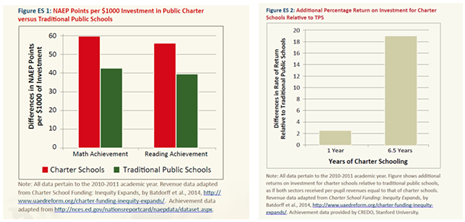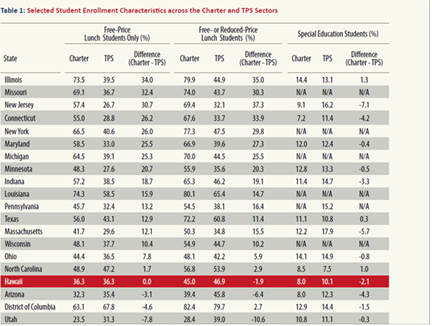Investing in Student Outcomes: Can We Get Spending Right in Public Schools?
Andrew Broy, Huffington Post
Last year, public education funding in the United States eclipsed the $600 billion mark for the first time. Despite the volumes written about specific school reforms and programs, precious little attention is paid to whether we are spending those dollars in a way that achieves our desired result–a quality education for all students and, ultimately, improved life opportunities for all. Unfortunately, the data suggest that we are not doing enough to prioritize funding in the areas most likely to have an impact on student outcomes.
A new national study entitled, “The Productivity of Public Charter Schools” sheds light on this very topic and should serve as the start of a long-needed discussion about school funding trade-offs. For the first time, researchers at the University of Arkansas’ Department of Education Reform examined the important issue of cost effectiveness and return-on-investment (ROI) of charter public schools compared to traditional district-run schools. It looked at two measures to compare financial input with academic and long-term results. First, cost effectiveness was measured by comparing per pupil funding to National Assessment of Education Progress (NAEP) scores for both charter and district schools. Second, the return on investment was examined by comparing learning gains developed over time to an estimate of economic return over a students’ lifetime.
The results are impressive. Despite historical underfunding for charter public schools in comparison to district-run schools, the study found that charter public schools produce more learning with less money. For every $1,000 invested in education, the study found that charter schools, on average, scored about 40 percent higher in math and reading when compared to traditional district-run schools.
Charter schools are unique public school options for families. They are granted flexibility and freedom to be innovative and tailor curriculum and school culture to student and community needs in exchange for strict accountability and improved academic outcomes. Charter public schools all across the country are improving student outcomes and changing the trajectory of low-income and minority students’ lives by providing critical access to quality schools that develop the skills and knowledge necessary to persist in college and compete for jobs in the 21st century.
The results of this study in Illinois were particularly compelling. The study found that among the states studied, Illinois charter public schools serve the highest percentage of low-income (based on free and reduced lunch students) and special education students when compared to district-run schools.
Despite serving a population of students that are widely recognized as more expensive to educate, these unique public school models are improving academic growth and student outcomes. However, current Illinois law allows for charter public school students to be funded at only 75% of what students attending district-run schools are funded. All students deserve a quality education and the resources needed to get it. Imagine the possibilities for students if we prioritized efficiency and effectiveness in our public school system when allocating resources.
There are certainly reasonable limitations to the data set examined. Long-term earnings predictions are a blunt instrument to gauge the effectiveness of public schools. Likewise, examining the NAEP data in a few, select grades does not paint a full picture of longitudinal achievement with the same set of students over time, which is a better measure of relative school quality. Nevertheless, these data suggest strongly that educational efficiency analysis should be included in all the current debates about public education reforms.
We urge lawmakers and district leadership to consider the return on taxpayers’ investment for our public schools when allocating limited funds. If we are to improve our public education system for all students, academic growth and student outcomes must be the main driver in all decision-making. Charter public schools work and are delivering on the promise to families of improving academic achievement and opportunity. We hope more studies are commissioned to examine these issues for the betterment of public schools. Investing in our schools is an investment in the futures of our students and our communities – let’s make it a smart one.












